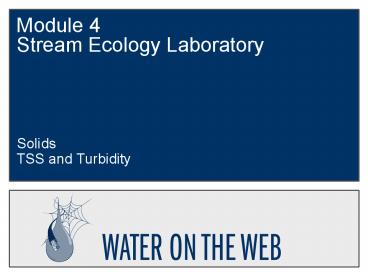Module 4 Stream Ecology Laboratory - PowerPoint PPT Presentation
Title:
Module 4 Stream Ecology Laboratory
Description:
Sediment plume off the south shore of Lake Superior ... collect from ... plankton and other microscopic organisms. Field turbidity measurements ... – PowerPoint PPT presentation
Number of Views:82
Avg rating:3.0/5.0
Title: Module 4 Stream Ecology Laboratory
1
Module 4 Stream Ecology Laboratory
- SolidsTSS and Turbidity
2
Total Suspended Solids
- Sediment plume off the south shore of Lake
Superior
3
Total Suspended Solids
- SAMPLING CONCERNS
- collect from undisturbed water
- when standing in a stream, reach upstream into
the current for the sample
- In lakes, boat propeller action also may disrupt
sediments in shallow areas - avoid sampling from temporarily disrupted area
4
Total Suspended Solids
TSS, as well as turbidity and any other parameter
dominated by the particulate fraction, can be
very patchy - it may be wise to composite from a
number of spots within the sites area
5
Total Suspended Solids
Figure 1
- filter a known amount of water through a
pre-washed, pre-dried at 103-105 oC, pre-weighed
( 0.5 mg) filter - rinse, dry and reweigh to
calculate TSS in mg/L - possibly save the
filters for other analyses such as volatile
suspended solids (VSS) that estimates organic
matter
6
(No Transcript)
7
(No Transcript)
8
Total Suspended Solids
Analytical balance
Drying oven
Filter and petri dish
9
TSS Methodology
- Calculate TSS by using the equation below
- TSS (mg/L) (A-B1000)/C
- where
- A final dried weight of the filter (in
milligrams mg) - B Initial weight of the filter (in milligrams
mg) - C Volume of water filtered (in Liters)
10
How does Turbidity relate to TSS ?
A general rule of thumb 1 mgTSS/L 1.0 - 1.5
NTUs of turbidity BUT Turbidity scattering
depends on particle size so this is only a rough
approximation
11
- Turbidity-Transparency Tube
- (for streams, ponds, wetlands, some coastal zones)
May have stopper and valve
12
- Turbidity-Transparency Tube
- Analogous to secchi depth in lakes a measure of
the dissolved and particulate material in the
water - Useful for shallow water bodies where a secchi
would still be visible on the bottom or fast
moving streams - Best for clearwater bodies of water (not stained
with dissolved organic compounds from bogs) but
not too clear water - It is a good measure of turbidity and suspended
sediment (TSS) - Used in many volunteer stream monitoring programs
Image http//www.watermonitoringequip.com/
13
How does Turbidity relate to TSS ?
A general rule of thumb 1 mgTSS/L 1.0 - 1.5
NTUs of turbidity BUT Turbidity scattering
depends on particle size so this is only a rough
approximation
14
Field Profiles-Turbidity
- Turbidity measures the scattering effect
suspended particles have on light - inorganics like clay and silt
- organic material, both fine and colored
- plankton and other microscopic organisms
- Field turbidity measurements are made with
- turbidimeters (bench meter for discrete samples)
- Submersible turbidity sensors (Note - USGS
currently considers this a qualitative method) - Transparency or turbidity tubes
15
Turbidimeters -Nephelometric optics
- Principle
- nephelometric turbidity estimated by the
scattering effect suspended particles have on
light - detector is at 90o from the light source
- Units
- Nephelometric Turbidity Units (NTU)
- standards are formazin or other certified
material - JTUs are from an older technology in which a
candle flame was viewed through a tube of water - 1 NTU 1 JTU (Jackson Turbidity Unit)
16
Bench vs Submersible Turbidimeters
Discrete depth - collect water sample and analyze
water in Lab
vs Continuous profile using submersible sensor
YSI 6820 with unwiped turbidity
YSI wiping turbidity
Hydrolab
17
Field profiles-turbidity
- Sensor calibration
- Turbidity free water zero (0 NTU) standard
- USGS recommends filtering either sample water or
deionized water through a 0.2 um or smaller
filter to remove particles - WOW uses deionized water that is degassed by
sparging (bubbling) with helium to minimize air
bubbles that give false turbidity readings - Standards range depends on anticipated sample
values - lakes - typically 0-20 NTU
- streams and wetlands - 0-20, 0-50 or 0-100 NTU
- 2 non-zero standards typically adequate (response
is linear) - formazin particles (either from a recipe or
purchase a certified, concentrated stock solution
(usually 4000 NTU) - other commercially available materials -
polystyrene - need to worry about storage limits - Primary
stock of 400 NTUs lasts lt 1 month when
refrigerated. Dilute working standards from
intermediate stock solution daily.
18
Field profiles-turbidity - calibration standards
prep
19
Field Probes-turbidity
- Comparability of different methods
- With the proliferation of automated in situ
turbidity sensors there is concern about the
comparability of measurements taken using very
different optical geometries, light sources and
light sensors. - The US Geological Survey and US Environmental
Protection Agency are currently (August 2002)
developing testing procedures for a field
comparison of a number of instruments produced by
different manufacturers. We will include these
results when they become available. - Standard Methods refers to
- APHA.1998. Standard methods for the examination
of water and wastewater. American Public Health
Association, Washington, D.C.































